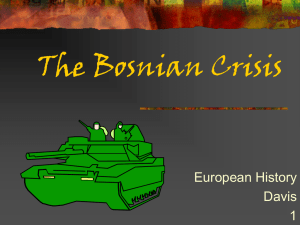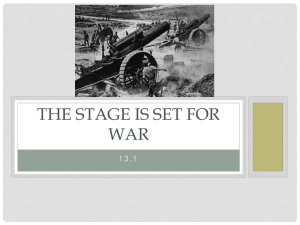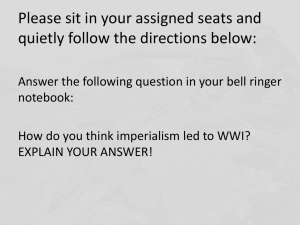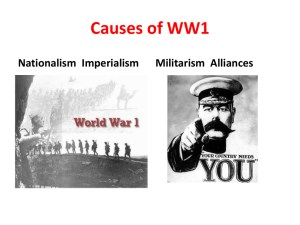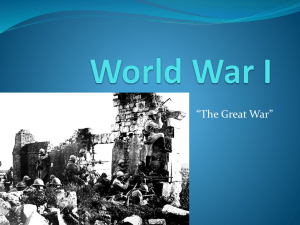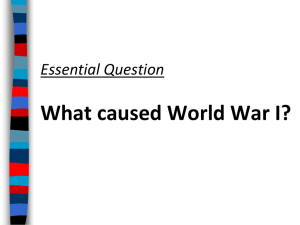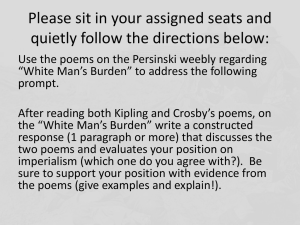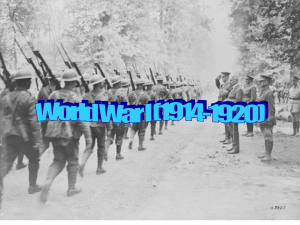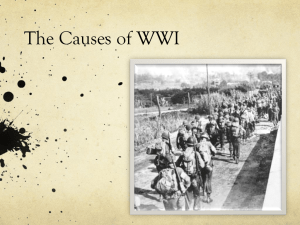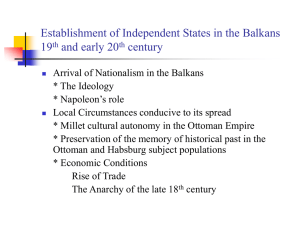The Bosnian Crisis 1908 File
advertisement
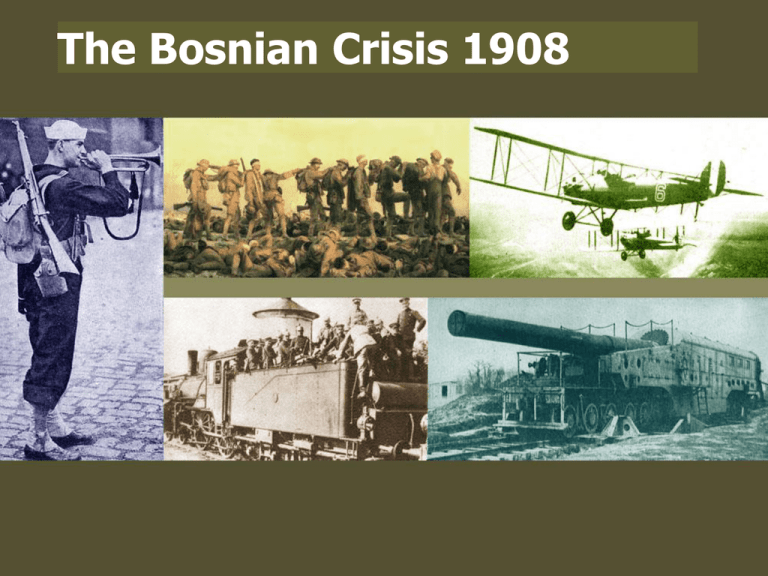
The Bosnian Crisis 1908 THE BALKANS The Balkans is the name given to a large area in South-East Europe. As this map shows, it contains a complex mixture of cultures with a long history of distrust and conflict. The Balkans in the early 20th century The Balkans were a seething mixture of competing ambitions between imperial powers and increasing nationalism, as shown by this map. Views of the Balkans “The whole of the Balkans is not worth the bones of a single Pomeranian grenadier”. (Bismarck) “Some damn thing in the Balkans will set it (i.e. the next war) off “ (Bismarck again) “The whole world is festering With unhappy souls. The French hate the Germans, The Germans hate the Poles; Italians hate Yugoslavs, South Africans hate the Dutch, And I don't like anybody very much “ Kingston Trio Merry Minuet Clash of empires - Turkey Turkey was referred to as the “Sick Man of Europe”. Turkey still retained control of some territories in the Balkans area, which were left over from conquests centuries ago. Clash of Empires - Russia Russia had always had an interest in developing trade through their ice-free Black Sea ports. Turkey controlled access between the Mediterranean and Black Seas. Russia supported the interests of fellow Orthodox Slavs Russia’s interest in the Balkans was to have allies that would support her in her desire to have open access to the Mediterranean Sea Clash of Empires – Austria-Hungary Austria-Hungary had gained control of some areas in the northern Balkans which were part of her multi-cultural empire. Austria-Hungary was concerned about nationalist unrest, especially the growing rise of Serbia. Austria-Hungary feared that other nationalities under its control would agitate to split from the empire. Pan-Slavism This historical force was the idea that all those groups of Slavic origin should combine together into one large independent state. Serbia saw itself as the core of this new Pan-Slavic state. Austria-Hungary saw the desire for Slav nationalism as a direct threat to its empire. Russia’s support for Serbia created tension with Austria-Hungary. The Young Turks In 1908, the Turkish Sultan Abdul-Hamid II was forced to accede to the demands of the Young Turks, a group of army officers who demanded that constitutional rule be restored in Turkey. Austria-Hungary’s opportunity Austria-Hungary wanted to prevent these Young Turks from regaining control of Bosnia and Herzegovina. Aerenthal, the Austrian Foreign Minister (right) arranged a secret meeting was with his Russian counterpart Alexander Isvolsky. The secret deal Aerenthal and Isvolsky (right) secretly agreed that Austria would support Russian moves to gain its warships free access to the Mediterranean from the Black Sea. In return Austria-Hungary would annex Bosnia and Herzegovina. The deal falls apart Isvolsky needed to return to Russia to brief the Tsar’s government about this deal, and to get support from Britain and France for the deal. However, before this was achieved, the Austrians went ahead with the annexation of Bosnia and Herzegovina. Austria-Hungary’s action caused international concern. Relations worsen Serbia was outraged by Austria’s annexation, and appealed to Russia for help in fighting the annexation. Russia was too weak from its defeat by Japan, and instead called for an international conference to settle the issue. Austria-Hungary refused, and was backed by Germany, who promised to mobilise in Austria’s defence if Russia mobilised. Russia could not face both states and had to back down. Consequences of the crisis Russia was humiliated and embittered by Austria’s actions. It increased the pace of its rearmament. It would not back down again. Serbia remained furious at Austria-Hungary’s frustration of its Pan-Slav ambitions and began openly supporting nationalist terror groups. The crisis revealed how desperate Germany was to retain the loyalty of her only remaining European ally. Supportive reading: Mills et. al. Pg 20-21 Applying this information to AS 90469 This standard examines how a force or movement influenced people’s lives. You are required to cover: Causes of an event related to a force/ movement Consequences of an event related to a force/movement How the force/movement influenced people’s lives A suitable force or movement IMPERIALISM, because this crisis is based on competing imperial ambitions, especially between Austria-Hungary and Russia ALLIANCE SYSTEM, because Germany backed its ally Austria-Hungary in a dispute with Russia, who did not at that time have confident backing from France (or Britain) NATIONALISM, because Serbia had ambitions to create a larger Pan-Slav state in the Balkans Of these, IMPERIALISM is the best choice because it offers more opportunity to examine the influence on people’s lives Causes of the crisis Long term – Turkish weakness in Bosnia, Russian aspirations to have access to the Mediterranean Sea, Austrian desire to frustrate Serbian nationalist ambitions Short term – Austrian actions in annexing Bosnia before Russia could consult other powers, German support for Austria, Russian military weakness Consequences of the crisis Russian humiliation Serbian frustration German desperation Influence of Imperialism on people’s lives Isvolsky was humiliated by being tricked by Aerenthal. The Russian Tsar was forced to disown Isvolsky’s plan for expanding Russian influence in the Balkans. Russian politicians were angry at Austria’s and Germany’s actions, and were determined not to back down again. Serbian politicians were angry at Austria’s frustration of their nationalist ambitions, annoyed that Russia would not back them and looked for other ways to reclaim what they thought was important to their national interests. British and French politicians were alarmed at international tensions caused by Austria’s and Russia’s conflicting imperial ambitions.
